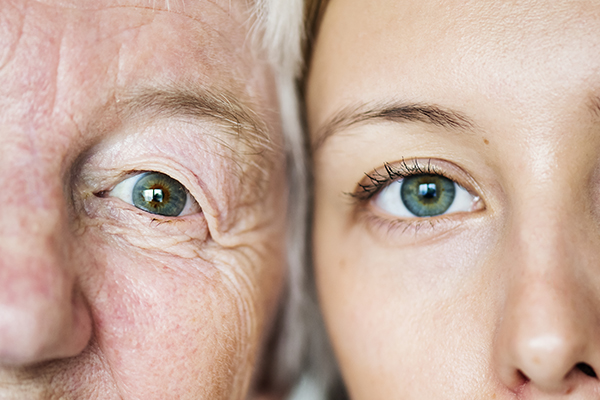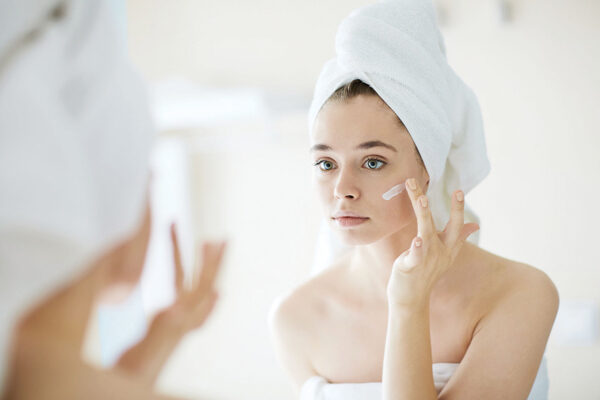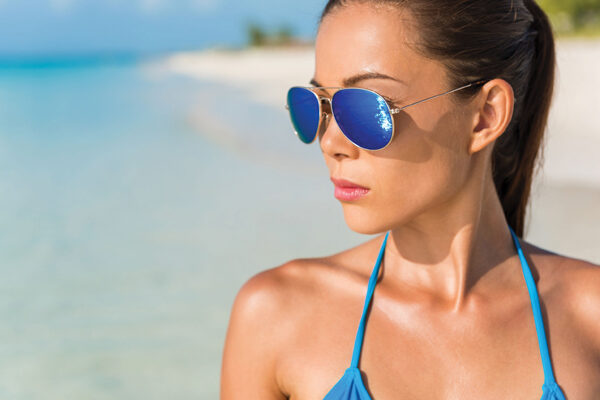What Do Your Eyes Say?
What Do Your Eyes Say?
THE EYE CONTOUR AREA — TYPICAL PROBLEMS AND INNOVATIVE TREATMENTS
The eyes are the most dominant part of our face. They are the mirrors of the soul, attest to our personality and express feelings. When the skin in the eye area is welltreated and nourished, the face looks vital and radiant. Yet, this area is also the first to disclose the various age signs. The unique characteristics of the eye contour area, which set it apart from the rest of the facial skin, are the reason for this.
The skin in the eye contour area is much more delicate and much thinner than the rest of the facial areas. In fact, the thickness of the skin in the eye contour reaches on average a fourth of the thickness in the other areas. While the thickness of the skin is usually 2 millimeters on average, the thickness of the skin around the eyes is only 0.5 millimeters, and it includes a very thin layer of subcutaneous fat. As a result, it is more delicate and vulnerable to the accumulated influence of environmental damages, including the effects of the solar radiation, winds, extreme cold, air conditioners
and more.
In addition, unlike other areas, there are no sebaceous glands in the eye contour area and therefore, it is fatfree and more disposed to dryness. The thin layer of the subcutaneous fat in this area combined with capillaries that are very dense, makes it more predisposed to
puffiness.
The common and particularly bothersome problems in this area include wrinkles and fine lines, black circles, bags and puffiness, as well as sunken eyes. Let us uncover the causes for these problems and the ways they can be treated.
Wrinkles and Fine Lines Around the Eyes
The area of the eye contour is characterized by ample movement, since we tend to perform a great number of facial gestures using our eyes, oftentimes without even being aware of the fact. These actions cause the contraction of the orbicularis oculi muscle—a circular shaped muscle that encircles the eye—and constitute the main cause for wrinkles and fine lines in the corners of the eyes (crow’s feet) and between the eyebrows. The causes for the premature appearance of these
wrinkles and fine lines are diversified:

• Increased exposure to the sun – this is the main cause for the appearance of wrinkles in general and not only in the eye area, but it significantly affects this thin and delicate skin. The damage caused by the rays of the sun is manifested by the appearance of free radicals in the skin. These active molecules have a destructive effect on the skin cells and the connective tissue.
• Vision problems – in order to overcome problems of near-sightedness and far-sightedness, we tend to blink and squint, and as a result, we accelerate the appearanceof wrinkles in the corners of the
eye (“crow’s feet”).
• Smoking – numerous studies have found that smokers are more predisposed to the premature appearance of “crow’s feet”, since smoking increases the activity of the free radicals, and in addition, causes increased blinking due to the irritation of the eyes by the cigarette smoke.
• Improper care – when the skin in the area of the eye contour is dry and is unnourished, its elasticity decreases, and therefore, the influence of the facial gestures increases, accumulates with time, and gives our eyes a tired, sagging and wrinkled look.
Bags and Puffiness Under the Eyes
The main cause for the appearance of “bags” under the eyes is genetic. In this condition, which develops gradually, the skin beneath the eyes first become saggy and dwindled. Later, the fat that lines the lower eyelid begins to move from its place and slides downward into the empty hollow created by the dwindling of the skin. In such case, the solution is a cosmetic surgery, in which the fat is removed from the skin and the skin is stretched. In contrast to the “bags”, puffiness beneath the eyes can be caused by variousdiseases and additional causes, such as:
• Kidney diseases
• Excessive alcohol consumption, which burdens the kidneys, whose role is to filter the fluids in the body.
• Excessive consumption of salt, which also causes edema and fluid retention.
• Hypertension and various diseases that damage the lymphatic drainage.
• Temporary factors, such as sleep deprivation, prolonged crying, and the use of unsuitable
cosmetic products.
Black Circles
The appearance of dullness under the eyes stems from the reflection of the blood in the capillaries in this area, which is covered by a dense net of blood vessels. While in the arteries the color of the oxygen-rich hemoglobin is red, in the veins, the color of the hemoglobin after releasing the oxygen varies from purplish-blue to brown. Since the skin in the eye contour is very thin and the capillaries are delicate, these pigments are reflected and create the appearance of dark circles that
encircle the eye. There are diversified reasons for this phenomenon as well, since the delicate blood vessels
respond with increased sensitivity to various factors:
• Genetics – expressed by a structural problem of the blood vessels and/or especially thin and
transparent skin.
• Anemia and vitamin deficiency – studies have found that iron deficiency is a central cause for the appearance of dullness in the area of the eye contour. In addition, anemia and vitamin deficiency cause paleness, which makes the capillaries beneath the skin even more salient.
• Dehydration – insufficient drinking causes the shrinking of the blood vessels in the area, and as a result, the blood in the shrunken capillaries is more concentrated and salient.
• Sleep deprivation – fatigue and sleep deprivation damage the blood flow, a fact that also leads to a higher concentration of the blood in the capillaries
around the eyes.
• Smoking – smoking is a known cause for damage to the function of the blood vessels. In addition to the insertion of various toxins into the blood stream, it also damages the blood flow. This happens of course in all areas of the body, but it is especially salient in the delicate blood vessels of the eye contour.
Sunken Eyes
This common problem is caused by the skin’s aging process as a result of the gradual absorption of the subcutaneous fat in the area. However, it also appears among young people, as a result of a congenital structure or due to the absorption of fat following a drastic loss of weight. For some people, the hollows also create an illusion of darkness beneath the eyes, with the darkness actually being the shadow of the lower eyelid.
How to Reduce the Appearance of the Damages and Inhibit the Age Signs in the Area of the Eye Contour
A regular care routine is not enough to protect this thin and delicate area. In order to prevent the premature appearance of the damages, it is important to
meticulously abide by the following rules:
• Use products that are specifically designated for the eye area – in recent years, designated products that are specifically suited for this area have been developed. hese products are based on ingredients that operate to improve the lymphatic drainage, increase the moisture, reduce puffiness and bags under the eyes, decrease and mooth out the wrinkles. Therefore, for example, unique peptides, such as acetyl tetrapeptide-5 and hexapeptide-10, operate to improve the blood flow and lymphaticdrainage. Thus, they act to significantly reduce the bags and black circles, decrease the black circles and strengthen and firm the skin beneath the eye area. nother efficient ingredient is caffeine, which has been proven to have the ability to stimulate the cells’ activity and the blood and lymph flow, thus facilitating the
drainageof the fluids from the interstitial compartment and the reduction of the puffiness and bags. In addition, antioxidants and antiinflammation ingredients, such as green tea and calendula, assist in caring for the delicate skin and facilitate the neutralization of the free radicals’ activity.
• Avoid using unsuitable cosmetic products – some of the care products may be too active and/or high in fat for this area. As a result, they may cause a problem in the ymphatic drainage, edema, and the appearance of bags under the eyes. In addition, the over-stimulation by unsuitable products may cause inflammation that also contributes to the aging of the skin.
• Protect the eye contour from the solar radiation— use sunglasses that protect from the UV radiation in the summer and in the winter, and apply sunscreen around the eyes as well. Studies indicate that this is one of the areas that most people tend to forget, and therefore expose it to the sun’s damages.
• Make sure to get sufficient sleep – as mentioned, sleep deprivation contributes to the puffiness and tired appearance of the eye area.
• Maintain a healthy nutrition – in order to provide a sufficient quantity of vitamins and minerals.
• Limit the consumption of salt – decrease the consumption of processed foods that contain large amounts of salt. In contrast, increase the consumption of diuretic foods, such as parsley and asparagus, which reduce edema and swelling.
• Consume alcohol in moderation – moderate amounts of alcohol can be health-beneficial, but it is important to avoid excessive alcohol
consumption.
• Undergo periodic eye checks – and when necessary, get fitted with eyeglasses.
Designated Treatments for the Eye Contour Area
These days, advanced osmetic roducts offer effective solutions that help reduce expression wrinkles and fine lines around the eyes, strengthen the skin structure,
facilitate its firming, increase the level of moisture and improve its pliability. A substantial emphasis is placed at HL Laboratories on the treatment of the eye contour
area. In order to care for and rehabilitate the eye contour area, HL has developed designated products based on ingredients specifically suited for this delicate and sensitive area, which assist the achievement of effective results without causing irritation or damage to the skin.
C THE SUCCESS is a line that operates to decelerate the skin’s aging process, to repair and rehabilitate damages and aging signs caused by processes related to age and accumulated exposure to the sun. The products of the line contain an active combination of vitamin C, orange oil and grapefruit extract, which operate to impede the skin’s aging processes, to reduce the depth of the wrinkles and fine lines, to firmand grant a radiant, even skin tone.
The line includes:
C THE SUCCESS INTENSIVE EYE CREAM, which is based on vitamin C, and operates to nourish, strengthen the collagen and elastin fibers, diminish expression
lines, and provides the area of the eye contour with intensive moisture.
PERFECT TIME is a line that provides an accurate response for the needs of mature skin. The line’s products are based on quality ingredients, innovative lipopeptides
and essential amino acids, which operate to increase the volume of the subcutaneous fat, and thus, to fill the wrinkles and smoothen the skin. Moreover, the line’s products firm and strengthen the contour lines of the face, neck and décolleté, and grant a tighter and younger look.
The line includes PERFECT TIME ANTI-WRINKLE EYE CREAM, a cream enriched with caffeine and lipopeptides that operates to reduce wrinkles and blur puffiness in the eye contour area, and grants a radiant young look.
JUVELAST is an innovative and highly effective linefor the rehabilitation and nourishment of dry skin. The line is based on an HL exclusive patent called DNA
CoFactor, which was scientifically tested and proven in clinical studies to be especially efficient in the improvement of the skin texture and the reduction of the depth of wrinkles.
The line includes JUVELAST NOURISHING EYE CREAM – an eye cream for nourishing the skin and blurring expression lines and puffiness in the eye contour
area. The cream is based on a copper-peptide complex and a liposome from an extract of the Arabidopsis plant, which neutralizes the damages of free radicals.
In addition, it contains cupuaçu and murumuru butters to soften the skin and improve pliability, Brazil nut oil rich in omega-6 and omega-9, as well as peptides and ceramides to reduce wrinkles.
DERMALIGHT is a powerful therapeutic line for lightening spots and hyperpigmentation. The line is based on acids, active ingredients and additional lightening substances, which significantly increase the treatment’s efficiency and contribute to the lightening of the skin and the creation of an even
skin tone.
The line includes DERMALIGHT CORRECTIVE EYE CREAM WITH/WITHOUT MAKE-UP – a cream enriched with caffeine and quinoa extract to reduce puffiness
and darkness under the eyes, a copper complex to reduce deep wrinkles, and vitamin C to grant an even
and radiant look.


















